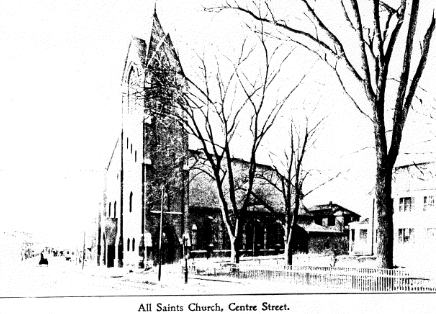
10 Apr The Forgotten All Saints Church
HBI recently submitted a proposal to redevelop the historic Dudley house at 167 Centre Street in Roxbury. Built circa 1825 for David and Hannah Dudley and their family, the house remained in the Dudley family until 1896, though much of the large estate had been subdivided for development in the early 1890s. One such development parcel was purchased by Bishop John J. Williams, 4th Archbishop of the Roman Catholic Archdiocese in Boston for the construction of the Church of All Saints.
The decision to build a new Roman Catholic church in this neighborhood was spearheaded by Hugh P. Smyth, the rector of nearby St. Joseph’s church, which served a mainly Irish congregation. The ambitious Father Smyth had overseen the construction of 12 churches before beginning work on All Saints, as well as the renovation of St. Joseph’s and the construction of two parochial schools, a rectory and convent. Following his completion of the St. Joseph’s complex, construction began on the Church of All Saints in 1893 to accommodate the growing population of Catholics in Roxbury.

1873

1899
Unfortunately, clear images of All Saints are hard to find. Dedicated in 1897, it was designed by W.H. and J.A. McGinty of Boston, reportedly with much input from Father Smyth. It was Gothic Revival in style, and described as being built of “Roxbury stone” – presumably Puddingstone – with granite trim and a pressed brick superstructure. The church was entered through a corner tower finished with terra cotta moldings. The sanctuary was octagonal in form, and opened into a vestry. It was designed to accommodate between 800 and 1,000 people. The parish at its opening numbered about 3,000, its territory bounded by Highland Street, starting from Roxbury Street, and continued from Marcella Street to Seaver Street near Washington Street.

All Saints Church in 1897. The Dudley house can be seen at the right.
Also in 1897, the Archdiocese acquired the Dudley house for use as All Saints’ rectory. The two story house was significantly altered by the church, including the addition of a third floor with a hip roof and a semi-circular, columned entrance portico. The Dudley house continued as All Saints’ rectory until 1968, when it was taken by the Department of Public Works for the construction of a new highway. Because of the Dudley house’s historical significance, it was spared from demolition, but sadly All Saints church was not so fortunate. The church was demolished, along with many other houses and businesses, for the I-695 Highway that wasn’t built. What was once was a dense urban neighborhood is now a parking lot for Roxbury Community College. All that remains of the All Saints church is the house that served as its rectory for at least as long as it served as a home for the Dudley family.



